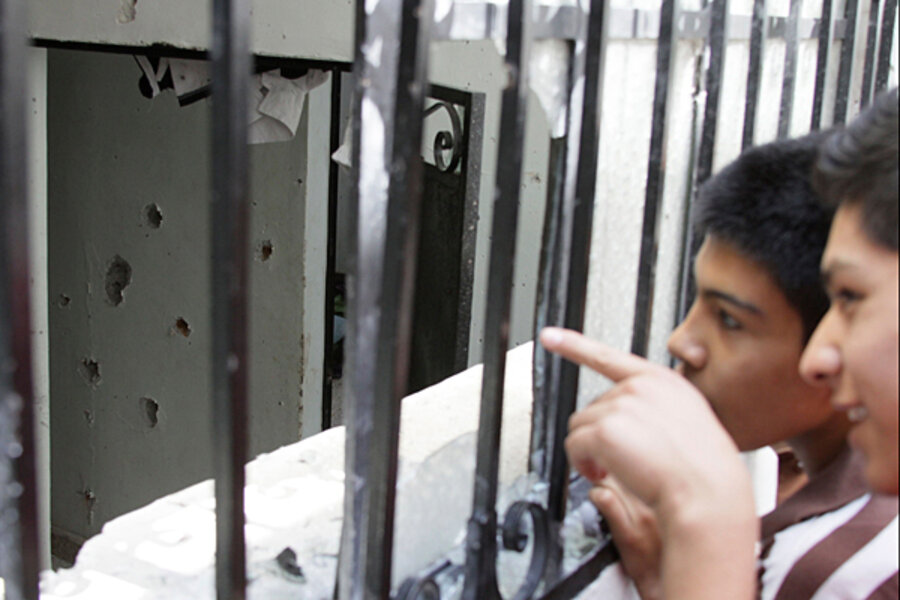Mexico drug war: Has Felipe Calderón lost control?
Loading...
| Mexico City
An attack on a rehabilitation center in Chihuahua leaves 19 dead. Twenty-eight inmates die in a prison fight in the state of Sinaloa. A dozen federal officials are ambushed and killed in the state of Michoacan. A shootout between gunmen and federal officials leave more than a dozen dead in a tourist town.
This is not a news reel replaying Mexico's “worst” moments of the decade, or even its worst of the year. It's just the past six days.
June could turn out to be one of the most violent months Mexico has faced since President Felipe Calderón took office in December of 2006, dispatching the military to fight organized crime.
IN PICTURES: Mexico's drug war
Since then death tolls have mounted – with nearly 23,000 killed since he became president – and the incessant headlines, including of the past week, appear to be causing a certain defense mechanism to rise in government quarters.
On Monday, President Calderón published a two-page editorial in newspapers across the country defending his strategy, arguing that he had no choice and that Mexicans must remain stoic.
But many Mexicans have lost faith.
“[Calderón] has lost the reins of the country, not partially but totally,” writes journalist and columnist Lydia Cacho in a column that appeared 14 pages before the president's missive in the daily El Universal.
President Calderón's essay
In the 5,000-word essay, Calderón is clear about what he believes are the main causes of the problem. The consumption of drugs in the US and easy access to arms (which he also faults the US for) are two main reasons, along with a lack of educational and work opportunities.
The editorial repeats an argument the government has long maintained: that the violence is due in part to the weakening and splintering of groups and that 90 percent of those killed are believed to have ties to organized crime.
Calderón reiterates the necessity of a strategy that includes fighting the groups themselves, improving law and justice, and strengthening international cooperation, such as with the $1.3 billion Merida Initiative that the US has promised Mexico.
“Now is not the moment to let down guards or give in,” the president concludes.
Was this recapitulation or a relaunching of a strategy? That is what Salvador Garcia Soto, a columnist in El Universal, questions. Across Mexico, says his column in Tuesday's newspaper, many want to know if this is an argument for what is ahead or a justification of what has been done.
A shift in strategy?
But Calderón is also hinting of a change in strategy. The president said he would hire a public relations firm to improve Mexico's image, according to the Associated Press. He also said he would clamp down on dollar cash transactions, in an apparent bid to stem money laundering.
It remains to be seen what lies ahead, but there is no doubt that the president, and his flaks, face a tough road ahead – even judging from the past two days alone.
In fresh violence Tuesday, soldiers and gunmen battled outside Taxco, a pretty hillside town of white-washed homes and cobblestone roads, after soldiers investigated a suspected safehouse. More than a dozen suspected gunmen were killed.
Taxco serves as a stopover for tourists searching for silver, often en route to Acapulco or other destinations along the Pacific coast. It is also where officials uncovered a mass grave with 55 bodies in an old mine purportedly used as a dumping ground for drug traffickers.
The day before in Michoacan, where the La Familia group has gained increasing notoriety, a dozen police officers were ambushed and left dead. This is not the first ambush in troubled Michoacan, the homestate of the president and the launching ground for his military initiative. The same day, inmates in the Pacific town of Mazatlan, in Sinaloa state, died during gun battles and knife fights between rivals in jail.
Related:
- US Border Patrol shooting (new video) threatens Mexico drug war cooperation
- Mexico mass grave highlights gruesome drug war
- Mexico news coverage
IN PICTURES: Mexico's drug war





